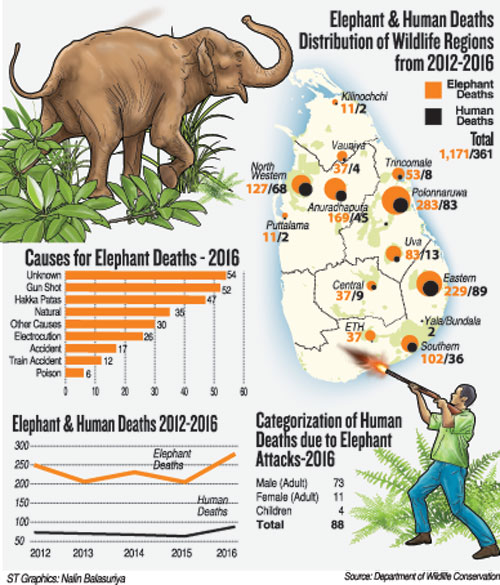News
The ignoble end of an iconic tusker
It took days of searching by Wildlife Department officials to locate the carcass of the much loved tusker ‘Galgamuwe Dalaputtuwa’ or ‘Loku Atha’ whose decomposed body was found on Wednesday.

Galgamuwe Dalaputtuwa was easily distinguishable (inset) the tusks that were recovered
The tusker had two bullet wounds, one on its head and another in the stomach, when it was found near Horowewa at Kahalla Palle-Kalle sanctuary. It was a tragic end to the life of a 50-year-old elephant that had come to be instantly recognisable by many in the country because of its unique feature of having crossed tusks.
The elephant had been missing for nearly two months. It was the discovery of two tusks in the possession of the Grama Sevaka Niladhari of Herathgama in Polpithigama Divisional Secretariat in Kurunegala on November 23 along with two elephant pearls (gaja muthu) by a team of Special Task Force personnel that led to the suspicion that the tusks may belong to the missing tusker.
After an extensive search, Wildlife officials found the carcass of an elephant which was confirmed to be that of Dalaputtuwa after a post mortem.
On Friday, six persons were apprehended and produced before the Mahara Magistrate Rajapaksa in connection with causing the death of the animal and trading in tusks. They were remanded till December 12.
The gun used to kill the tusker and the hack saw used to cut off the tusks were also found by police.
The tusker was blind in one eye having suffered a gunshot injury some years ago. He was also suffering from a wound on one of its legs having been the target of hunters previously.
Dr. Tharaka Prasad, the Director in charge of Wildlife Health at the Wildlife Department as well as the Chief Veterinary Surgeon, and Chandana Jayasinghe, veterinary surgeon of the North Western region, who conducted the post mortem confirmed that the tusker was shot in its belly and its head by using a 12 gauge bore gun.
The people of the area as well as groups of environmentalists have alleged that officials attached to the Department of Wildlife are behind the killing of the tusker.
Allegations are also levelled at the Department for not keeping track of the famous tusker.



